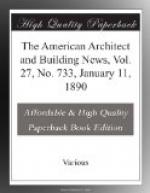Fire-pumps are generally too small for the work required of them, 500 gallons per minute being the minimum capacity recommended. For a five-story mill there should be an allowance of 250 gallons per minute for an effective stream through a 1-1/8-inch nozzle, and for lower buildings the estimate should rarely be less than 200 gallons for each stream.
Contrary to the general assumption, a ring nozzle is not so efficient as a smooth nozzle, the relative amount of discharge of ring and smooth nozzles of the same diameter being as three is to four. For stand-pipes 7/8-inch nozzles are recommended, but for yard hydrant service the diameter should never be less than one inch, and 1-1/8 inches generally fulfils the conditions of best service.
The yard hydrants should be placed at a distance of fifty feet from buildings, and covered with a house which should also contain hose, axes, bars, nozzles and spanners.
Water-mains about a mill-yard should be of ample capacity not to cause an excessive loss by friction, their diameter being based upon a limit of velocity of ten feet per second for the maximum delivery.
RESULTS.
These methods of supervision, building and equipment do not refer to any ideality, but to measures which have been widely carried into effect for the purpose of reducing the fire-loss; the result of such action being to diminish the cost of insuring industrial property engaged in such normally hazardous processes as textile manufacture and other industries, down to a yearly cost of less than one-fifth of one per cent. This has been accomplished by the consideration of sources of danger and their abatement, and by a course which has been in line with sound engineering principles, and also practical methods of manufacture; and it has thus been proved that it is cheaper to prevent a fire than to sustain a loss.
There has been no attempt made to credit individuals with their share in these features of mill development. They have been the outgrowth of a continual profiting by experience, adopting some features and modifying others. The concurrent action of the large number of minds engaged on the same problem has led to duplication of methods; but the whole progress has been a matter of slow, steady growth, advancing by hairs’ breadths, as the result of persistent efforts to adapt means to ends in the endeavor to reduce the cost of manufacture.
FOOTNOTES:
[Footnote 6: Abstract of a paper by Mr. C.J.H. Woodbury, read before the American Society of Mechanical Engineers.]
* * * * *
[Illustration: SOCIETIES]
THE NEWARK ARCHITECTURAL SKETCH-CLUB.




